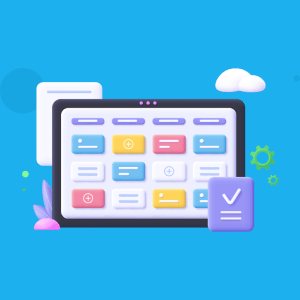Cognitive learning theory
Table of Contents
Learning and development is a dynamic field with new tools, processes, and methods constantly popping up.
But, to understand where we’re going, we have to know where we came from.
That’s why we’ve prepared this guide on Cognitive Learning Theory (CLT), one of the most influential and widely accepted frameworks that explain how people learn.
And don’t worry; we don’t just cover the theory. We’ll show you how to apply CLT in your employee training programs.
So buckle up and get ready to explore:
- What CLT is
- The differences between CLT and behaviorism
- CLTs you have to know about
- The benefits of cognitive learning
- Cognitive learning strategies you can implement in your organization
What is Cognitive Learning Theory (CLT)?
Cognitive Learning Theory (CLT) aims to understand what happens in peoples’ minds when they learn. It focuses on how the mind processes information through external stimuli and it into new knowledge.
So, rather than just responding to stimuli, learners mentally process new information before it becomes new knowledge.
To understand this better, we have to touch upon the concept of metacognition. Metacognition is awareness of the brain’s thoughts and thought processes. In simpler terms, it’s thinking about thinking.
One of the main contributors to CLT is the psychologist Jean Piaget, who’s also well-known for this theory of human cognitive development.
Piaget disagreed with the then-prevalent behaviorist theories of learning (we’ll get into that in the next section), which focused only on the observable behavior of learners.
As a result, CLT focuses on what processes happen as learners take in, interpret, store, and retrieve information.
According to the theory, these are the cognitive processes that happen:
- Attention
- Observation
- Perception
- Interpretation
- Organization
- Storing and retrieval
- Categorization
- Forming generalizations
Or, to simplify it:
- Comprehension—understanding the reason behind learning something
- Memory—cognitive learning discourages mechanical memorization; instead, learners should relate the new information to past experiences and form a deep understanding
- Application—learners should be able to use information from a learning experience in their jobs and daily lives
So, exactly what is the difference between CLTs and behavioral learning theories? We’ll explain that in the next section.
Behavioral vs. cognitive perspectives on learning theories
The main difference between the behavioral and cognitive perspectives is that behaviorist theories only look at learners’ externally observable behavior, while cognitive perspectives focus on internal mental processes.
Behaviorist theories view cognition as a black box. This means we cannot know what’s happening inside a learner’s mind.
On the other hand, cognitive psychology believes that learner behavior can be understood by studying internal mental processes. In other words, what’s going on inside the brain.
Cognitive psychologists and other cognitive learning theorists do look at how people behave, but mostly as an indicator of the internal mental processes.
Why does all this matter? Because understanding cognitive learning theory can help instructors provide more effective training strategies that cater to more types of students
Some CLT-based strategies include asking questions, giving learners opportunities to make errors, thinking aloud, and fostering self-reflection. More on that later.
In the next section of the guide, we’ll give an overview of three of the most widely accepted CLTs.
Three CLTs
Cognitivism has evolved over the years, expanding to include several theories on how people learn.
In this section, we’ll look at the three most widely used CLT theories to help you implement effective e-learning and training programs in your organization.
Theory #1: CLT
CLT explains how internal and external factors impact learners’ mental processes when they’re learning something.
Difficulties and delays in learning are visible when these mental processes aren’t working properly. For instance, a person might have attention, observation, or retrieval issues from long-term memory, among others.
Many educational psychologists have contributed to CLT over the years. Jerome Bruner recognized that there are links between mental processes and teaching, while Piaget focused on the role of the environment and on changes that take place in human cognitive structures as they develop.
Cognitive theories that emphasize the influence environment and social context has on learning are now the most widely adopted in psychology and learning experience design.
There are two main branches of CLT—social cognitive and cognitive behavioral theory. Read on to find out more about them.
Theory #2: Social Cognitive Theory
Social cognitive theory emphasizes the importance of social context in learning. Because of this, the social learning environment in which learning takes place is very important.
A learner’s internal thoughts and external factors both affect how they process new information during learning.
In brief, this theory tries to figure out how social interactions and the environment impact learning. This is important from an L&D standpoint.
Instructional designers can leverage the principles of social cognitive theory, adapting their learning strategies to facilitate better training outcomes and foster engagement.
Basic social cognitive theory concepts are:
- Reciprocal determinism: A person, their environment, and their behavior all interact and influence one another
- Positive and negative reinforcement: The way other people respond to certain behaviors, positively or negatively, affects future learning behaviors
- Observational learning: Learners can watch someone else perform an action (and the positive and negative consequences of the action) and repeat the actions themselves
Just an FYI, we have a whole guide on social learning theory, so give it a read.
Theory #3: Cognitive Behavioral Theory
The second branch of CLT is cognitive behavioral theory. This theory examines how our thoughts affect our behaviors and feelings. So, the way we think about something can impact how we learn.
This is especially important in education and employee training because it reveals the link between mindset and how we process and learn new information.
For instance, a study has found that highly motivated learners achieve better learning outcomes than those with less motivation. Those who had more motivation experienced less mind-wandering and distraction, leading to better knowledge retention.
The implications of this for corporate learning and development programs are massive. It means that if you want to have effective learning, you have to motivate your learners and help them cultivate a growth mindset.
Up next, we’ll look at the benefits of cognitive learning.
Four benefits of cognitive learning
Implementing cognitive learning strategies in an organization can garner significant benefits.
We look at the top four advantages of cognitive learning for your organization.
Benefit #1: Enhanced learning
Cognitive learning promotes life-long learning and learning agility. It empowers learners to build upon previous ideas and apply new concepts to existing knowledge. This builds confidence in their learning abilities, encouraging them to identify and apply the best learning methods for them.
As a result, cognitive learning enables a culture of continuous learning. Learners have a practically infinite capacity to learn, and each new bit of knowledge expands the overall store of information.
Ultimately, this enhances the overall quality of learning and skills development.
Benefit #2: Enhanced problem-solving skills
Effective problem-solving skills are among the most valuable tools any employee can have. While theoretical learning is important, it’s not useful if learners can’t apply it to real-world situations.
Luckily, cognitive learning strategies can equip employees with the skills needed for effective problem-solving. This is because cognitive learning discourages mechanical learning and memorization, instead promoting meaningful learning.
Meaningful learning encourages learners to think critically and reflect on how the learning material relates to real-world situations.
Benefit #3: Increased comprehension
Cognitive learning promotes understanding over mechanical memorization, creating relatable and meaningful learning experiences for learners.
As we know from adult learning theories, that’s especially important for adult learners. To make learning as effective as possible, adult learners need to understand why they are learning something and how the new knowledge and skills will help them professionally and personally.
When educators and trainers create learning environments with CLT in mind, they promote better comprehension and practical application of new knowledge. Instead of just memorizing facts, learners are able to reflect on the material and relate it to other things they already know.
Benefit #4: More confidence
Mindset plays a vital role in effective learning. CLT shows us that what learners believe about themselves and their abilities matters.
Simply put, if a learner doesn’t have confidence in their abilities, they’re less likely to engage and have the motivation to learn.
Educators and trainers can take advantage of cognitive learning strategies to motivate their learners.
For the learners themselves, confidence can come from mastering skills and knowledge and then using them to solve real-world problems. Continuous learning equips employees with the necessary skills to deal with complex workplace challenges.
Cognitive learning places great importance on understanding, which increases learners’ confidence when tackling new problems and knowledge.
Stay tuned to discover what kind of cognitive learning strategies to incorporate into your learning and development programs.
Three cognitive learning strategies to implement
Cognitive learning strategies use CLT as a basis to help learners process and retain new knowledge.
We’ve rounded up three cognitive learning strategies you can implement as part of your learning and development programs.
Strategy #1: Learner-centered
Learner-centered education has been a powerful trend in education for a while now. This goes for classrooms and organizations alike.
At its core, a learner-centered approach focuses on the learner’s past experiences and knowledge.
There are three main components of this strategy that you need to know:
- Accommodation: Introducing new information by modifying what the learners already know
- Assimilation: Separating the new knowledge from the existing knowledge
- Equilibrium: Balancing the new knowledge that a learner is trying to obtain with the old knowledge
L&D professionals can take advantage of this learning strategy in several ways:
- Develop and introduce new training programs based on what learners already know
- Provide more analogies in the training content to connect new information with old information
- Give practical examples of how the new knowledge and principles connect with what learners already know
Having a good Learning Management System (LMS) can help you out here because it makes it easy to combine existing learning objects to create new online training courses.
L&D teams can build personalized learning paths that build on what learners already know.
Strategy #2: Learning through discovery
Learning is a process that never truly ends, and encouraging learners to explore new ideas and attain knowledge on their own is a powerful strategy.
This learning strategy comes from the contributions of Jerome Bruner to CLT. From his work on studying cognitive learning in children, he suggests that teachers should encourage children to discover new information by themselves.
However, companies can apply this insight to the workplace as well. It’s not just children that review old knowledge as they learn something new—everyone does it.
Allowing employees to learn new skills and obtain new knowledge from new tasks and challenges makes learning more meaningful and engaging. At the same time, it encourages employees to solve real-world problems your organization faces.
Even more traditional learning methods can use some aspects of this strategy. For instance, a trainer can dedicate some time to learner questions and group discussions. Through discussing things and exchanging points of view, students can learn something new on their own.
The same goes if you’re delivering training via an LMS. Social learning features, such as forums and discussion boards, can motivate learners to look for answers on their own and discuss their findings.
Having an employee knowledge base on your LMS can also promote independent learning, honing your staff’s ability to seek out answers to workplace problems as they arise.
Strategy #3: Personalized learning
If you’ve read our glossary, you know we’re big fans of personalized learning. Personalized learning is a powerful learning strategy that recognizes that no two learners are the same.
Everyone has their learning style and learns better through different learning modes.
L&D teams can maximize the effectiveness and engagement of training programs by delivering personalized learning materials that resonate with individuals with different learning styles.
Modern LMSs make personalized learning strategies easier to implement through learning pathways, adaptive learning, interactive activities, and microlearning. Learning experience designers can create learning environments and content that allow learners to choose how their learning journey unfolds.
Plus, LMS reporting and analytics allow L&D teams to track individual learners’ performance.
Digital learning assistants can automatically suggest new training courses based on employees’ skills and learning progress.
Employees can choose content that looks interesting and relevant to their job roles and goals. That way, no two employees need to go through the exact same learning journey.
Before you head off to put cognitive learning theory into practice, stick with us as we sum up the key points.
Wrapping up
CLT is a scientific approach to learning that explains how internal mental processes and external factors affect learning.
Cognitive approaches focus on the internal mental processes that take place when a person is learning something new.
From CLT, educators and L&D professionals have developed strategies to help learner engagement, motivation, and knowledge retention.
A robust LMS can help your organization implement cognitive learning theory in its corporate training programs. From delivering personalized, learner-centric training content to tracking learner progress to facilitating interactive learning activities, it’s a powerful tool for any learning and development strategy.
For more insights into how learning and development can transform your organization, take a look at our glossary.








